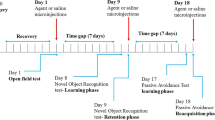Abstract
Rationale
It has been reported that 5-HT1A receptors modulate learning and memory and diverse pharmacological and genetic evidence supports this notion. Nevertheless, there are few works about expression of these receptors during memory formation.
Objective
We aimed to determine 5-HT1A receptor expression in brain areas of untrained, passive, and autoshaping trained groups of rats.
Methods
Ex vivo receptor autoradiography using the ligand agonist [3H]8-hydroxy-2-[di-n-propylamino]tetralin] (8-OH-DPAT) was used.
Results
The trained group relative to untrained animals showed increases of 5-HT1A receptor expression in 14 brain areas, decrements in 7, and no changes in 12. Thus, in contrast to untrained rats, 5-HT1A receptor expression of autoshaping trained rats was augmented in the tubercule olfactory, septal nucleus, nucleus accumbens, caudate putamen, globus pallidus, striate, and parietal (1 and 2), temporal cortex (1 and 3), granular retrosplenial cortex (1), amygdala, and median and dorsal raphe nuclei. In contrast, in the latter group, receptors were decreased in the CA1 area, hypothalamus dorsal, frontal cortex (1 and 3), occipital cortex, cingulate cortex (1 and 2), and cuneiform nucleus. There were significant differences between passive vs trained groups, but not regarding untrained rats, in the lateral olfactory tract, dentate gyrus, CA3 area, ventromedial hypothalamic, lateral hypothalamus, preoptic medial, frontal cortex (2), granular retrosplenial cortex (2), entorhinal cortex (1 and 2), piriform cortex, and substantia nigra.
Conclusions
These data suggest that upregulated, downregulated, and “silence” of 5-HT1A receptors in brain areas form part of neural circuits engaged in memory formation by demonstrating a high degree of specificity and memory mapping.



Similar content being viewed by others
References
Bert B, Dere E, Huston J, Wilhelmi N, Kusserow H, Theuring F, Fink H (2004) Mice transiently overexpressing the 5-HT1A receptor show deficient water maze but hole-board performance. Genes Brain Behav (submitted)
Buckner RL (2004) Memory and executive function in aging and AD: multiple factors that cause decline and reserve factors that compensate. Neuron 44:195–206
Gallistel CR, Fairhurst S, Balsam P (2004) The learning curve: implications of a quantitative analysis. Proc Nat Acad Sci U S A 101:13124–13131
Hoyer D, Clarke DE, Fozard JR, Hartig PR, Martin GR, Mylecharane EJ, Saxena PR, Humphrey PP (1994) International Union of Pharmacology classification of receptors for 5-hydroxytryptamine (serotonin). Pharmacol Rev 46:157–203
Hoyer D, Hannon J, Martin G (2002) Pharmacological and functional diversity of 5-HT receptors. Pharmacol Biochem Behav 71:533–554
Jacobs B, Azmitia E (1992) Structure and function of the brain serotonin system. Physiol Rev 72:165–229
Jeltsch H, Bertrand F, Galani R, Lazarus C, Schimchowitsch S, Cassel JC (2004) Intraseptal injection of the 5-HT1A/5-HT7 agonist 8-OH-DPAT and working memory in rats. Psychopharmacology 175:37–46
Lai MK, Tsang SW, Francis PT, Esiri MM, Keene J, Hope T, Chen CP (2003) Reduced serotonin 5-HT1A receptor binding in the temporal cortex correlates with aggressive behavior in Alzheimer disease. Brain Res 974:82–87
Manuel-Apolinar L, Meneses A (2004) 8-OH-DPAT facilitated memory consolidation and increased hippocampal and cortical cAMP production. Behav Brain Res 148:179–184
Meneses A (1999) 5-HT system and cognition. Neurosci Biobehav Rev 23:1111–1125
Meneses A (2002) Tianeptine: 5-HT uptake sites and 5-HT1-7 receptors modulate memory formation in an autoshaping Pavlovian/instrumental task. Neurosci Biobehav Rev 26:309–319
Meneses A (2003) A pharmacological analysis of an associative learning task: 5-HT1 to 5-HT7 receptor subtypes function on a Pavlovian/instrumental autoshaped memory. Learn Mem 0:363–372
Meneses A (2004) Effects of the 5-HT7 receptor antagonists SB-269970 and DR 4004 in autoshaping Pavlovian/instrumental learning task. Behav Brain Res 155:275–282
Meneses A, Terron JA (2001) Role of 5-HT1A and 5-HT7 receptors in the facilitatory response induced by 8-OH-DPAT on learning consolidation. Behav Brain Res 121:21–28
Meneses A, Manuel-Apolinar L, Rocha L, Castillo E, Castillo C (2004) Expression of the 5-HT receptors in rat brain during memory consolidation. Behav Brain Res 152:425–436
Murray EA, Wise SP (2004) What, if anything, is the medial temporal lobe, and how can the amygdala be part of it if there is no such thing? Neurobiol Learn Mem 82:178–198
Pazos A, Palacios JM (1985) Quantitative autoradiographic mapping of serotonin receptors in the rat brain: I. Serotonin-1 receptors. Brain Res 346:205–230
Paxinos G, Watson C (1986) The rat brain in stereotaxic coordinates, 2nd edn. Academic, San Diego, CA
Pugh JA, Gibbs TT, Rosene DL (2004) Relationship of serotonergic and nicotinic receptors to cognitive performance in the aging rhesus monkeys. Abstr Soc Neurosci 98.7
Sarnyai Z, Sibille EL, Pavlides C, Fenster RJ, McEwen BS, Tóth M (2000) Impaired hippocampal-dependent learning and functional abnormalities in the hippocampus in mice lacking serotonin1A receptors. Proc Natl Acad Sci U S A 97:14731–14736
Squire LR (2004) Memory systems of the brain: a brief history and current perspective. Neurobiol Learn Mem 82:171–177
Sumiyoshi T, Meltzer HY (2004) Serotonin 1A receptors in memory function. Am J Psychiatry 161:1505
Terry AV (2004) Drugs that targets serotonergic receptors. In: Buccafusco JJ (ed) Cognitive enhancing drugs. Birkhauser, Basel, Switzerland, pp 79–88
Tomie A, Di Poce J, Aguado A, Janes A, Benjamin D, Pohorecky L (2003) Effects of autoshaping procedures on [3H]-8-OH-DPAT-labeled 5-HT1a binding and [125I]-LSD-labeled 5-HT2a binding in rat brain. Brain Res 975:167–178
Yasuno F, Suhara T, Nakayama T, Ichimiya T, Okudo Y, Tacaño A, Ando T, Inoue M, Maeda J, Suzuki K (2003) Inhibitory effect of hippocampal 5-HT1A receptors on human explicit memory. Am J Psychiatry 160:334–340
Acknowledgements
This work was partially supported by CONACYT grant 39534-M. We thank Sofia Meneses-Goytia for language revision and Roberto Gonzalez for his expert assistance. Finally, we thank two anonymous reviewers for their comments and observations, which greatly helped to improve the present work.
Author information
Authors and Affiliations
Corresponding author
Rights and permissions
About this article
Cite this article
Luna-Munguía, H., Manuel-Apolinar, L., Rocha, L. et al. 5-HT1A receptor expression during memory formation. Psychopharmacology 181, 309–318 (2005). https://doi.org/10.1007/s00213-005-2240-4
Received:
Accepted:
Published:
Issue Date:
DOI: https://doi.org/10.1007/s00213-005-2240-4




